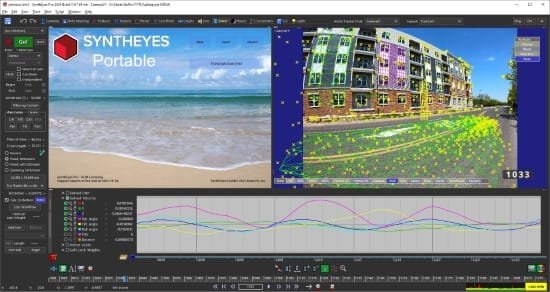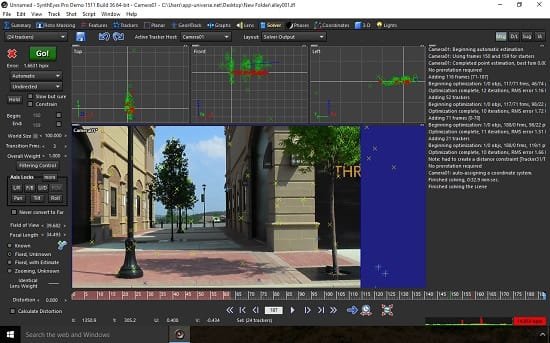Portable Syntheyes Pro 2304 Build 1056 (x64)

Syntheyes Portable is a top-of-the-line software solution for professional 3D motion tracking and match-moving. This advanced tool is designed for visual effects artists, filmmakers, and animators who require precise and accurate tracking of camera movements to seamlessly integrate CGI elements into live-action footage.
One of the standout features of Syntheyes Portable is its robust tracking algorithms, which are capable of analyzing complex camera movements and tracking markers with precision. Whether you are working on a Hollywood blockbuster or a small indie film, Syntheyes Portable has the capabilities to handle any tracking challenge you throw at it.
In addition to its advanced tracking capabilities, Syntheyes Portable offers a wide range of tools and features to streamline the match-moving process. From automatic marker detection to manual tracking controls, users have the flexibility to choose the tracking method that best suits their project needs. The software also supports a variety of tracking markers, including point clouds, grids, and user-defined shapes, giving users the freedom to track objects of any shape or size.
Furthermore, Syntheyes Portable offers integration with popular 3D animation and compositing software, allowing users to easily import and export camera data and 3D geometry for seamless integration into their workflow. This interoperability with industry-standard software makes it easy for users to incorporate tracked footage into their projects without any compatibility issues.
Another key feature of Syntheyes Portable is its user-friendly interface, which is designed to be intuitive and easy to navigate. Whether you are a seasoned professional or a beginner just starting out in the world of motion tracking, Syntheyes Portable makes it easy to get up and running quickly with its straightforward workflow and helpful tutorials.
Overall, Syntheyes Portable is a comprehensive and powerful tool for 3D motion tracking and match-moving that is trusted by professionals in the visual effects industry. With its advanced tracking algorithms, flexible tracking options, seamless integration with other software, and user-friendly interface, Syntheyes Portable is the go-to solution for anyone looking to achieve high-quality motion tracking results. Try it out today and experience the power of Syntheyes Portable for yourself.
SynthEyes™ is a standalone application optimized for camera, object, geometry, and planar tracking, stabilization, and motion capture, with high performance, a huge feature list, exports to many applications, and an affordable price. Use SynthEyes for critter insertion, fixing shaky shots, virtual sets, object removal, stereoscopic production, 360°VR, architectural previews, accident reconstruction, product placement, face and body capture, …
SynthEyes has been helping VFX artists since 2003 in more than 90 countries. Whether you’re starting out, or need to step up to real tracking power and performance, put SynthEyes to work today!
What can SynthEyes help me do? You can use SynthEyes to help insert animated creatures or vehicles; stabilize shaky conventional or 360°VR shots; extend or fix a set; add virtual sets to green-screen shoots; replace signs or insert monitor images; remove unwanted objects from shots; produce 360° virtual reality or 3D stereoscopic films; create architectural previews; reconstruct accidents or crashes; do product placements after the shoot; move imagery from one shot to another; add 3D cybernetic implants, cosmetic effects, or injuries to actors; produce panoramic backdrops or clean plates; build textured 3-D meshes from images; add 3-D particle effects; or capture body motion to drive computer-generated characters. And those are just the more common uses; we’re sure you can think of more.
What are its features? How much time do you have? For a longer list, click the “Features” item up top. Here’s a few to start. SynthEyes offers 3-D tracking, set reconstruction, stabilization, and motion capture. It handles camera tracking, 2- and 3-D planar tracking, object tracking with or without a reference mesh, geometry tracking, geometric hierarchy tracking, secondary tracking, camera+object tracking, fiducial tags, survey shots, multiple-shot tracking, tripod (nodal, 2.5-D) tracking, mixed tripod and translating shots, stereoscopic shots, nodal stereoscopic shots, zooming shots, 360° VR shots, lens distortion, light solving. A keyer simplifies and speeds tracking for green-screen shots. The image preprocessor helps remove grain, compression artifacts, off-centering, or varying lighting and improve low-contrast shots, or convert to and from 360° VR shots. Meshes can be built from tracking data, and their textures extracted from the image sequence, producing higher resolution and lower noise than any individual image.
SynthEyes offers complete control over the tracking process for challenging shots, including an efficient workflow for supervised trackers, combined automated/supervised tracking, offset tracking, incremental solving, rolling-shutter compensation, a hard and soft path locking system, distance constraints for low-perspective shots, and cross-camera constraints for stereo. A solver phase system lets you set up complex solving strategies with a visual node-based approach (not in Intro version). You can set up a coordinate system with tracker constraints, camera constraints, an automated ground-plane-finding tool, by aligning to a mesh, a line-based single-frame alignment system, manually, or with some cool phase techniques. The ViewShift system allows you to do object removals, combine split takes, generate animated texture maps, and more.
The Latest SynthEyes Portable Features
Don’t forget to use the Sug button in SynthEyes, ie the New-Feature.
- New “industry-standard” lens models in the solver and image preprocessor: 4th-order Brown-Conrady, 6th-order anamorphic (including rotation and horizontal and vertical scaling), and fisheye lens models, in match-moving-friendly and compositing-friendly versions. (Anamorphic lens models unavailable in the Intro version.)
- Animated lens model parameters. To achieve low-jitter results, parameters can be animated on specific key frames, with linear interpolation in between. The solver optimizes the key values to produce the best overall solution including the intermediate frames. This is much better approach than filtering, or solving on every frame independently! Parameters can be animated on every frame, mostly to help decide where to put key frames, but keying on every frame should not be used for final solves.
- New “anamorphic distance” solving, to accommodate anamorphic lenses with different horizontal and vertical entrance pupil (nodal point) locations. Anamorphic distance changes the basic perspective transform, addressing problems that cannot be corrected by any possible 2-D lens distortion. Supported in Alembic, Blender, FBX, Nuke, and USD(A) exporters by vertex caches for all meshes.
- Seven new SynthEyes 2304 tutorials.
- New Anamorphic Shots Guide.
- New “Lens/True Field of View” script computes and displays the field of view and focal length of the original image itself on the horizontal centerline. Compare these results to the on-set measurements, not the solver outputs, which correspond to the initial undistorted image or the output of the image preprocessor after running Lens Workflow.
- New focus (distance) informational channel added to cameras in the Graph Editor to help with lens breathing shots. Scripts to load focus or other metadata into the channel from shot metadata or YAML files.
- Major Nuke exporter update, including usage of the built-in Lens Distortion node (not STmaps) for 0-pass (overscan rendering), 1-pass, and 2-pass lens workflows. Support for the Nuke’s beta “New 3-D” system. Auto-run exported .nk files, or paste them into existing comps.
- Exports new distortion models (except fisheyes) to Fusion’s LensDistort node for 0-pass (overscan rendering), 1-pass, and 2-pass lens workflows. Option to include absolute mesh pathnames, for use with Deadline.
- New “Keep World Size” control on the Advanced Solver Settings panel for special circumstances where direct expert manual control is desired.
- Added “Force 8-bit ProRes” preference for M1 Minis to work around macOS Ventura bug.
- Workaround for a Windows issue that caused lidar meshes to be displayed much slower than necessary.

